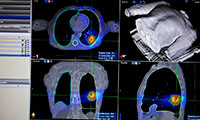Velocity AI
Getting a Better Look at Cancer: New Imaging Software Could Improve Cancer Treatment
Imagine cancer treatment as a war and the physician as the general who must find the critical targets for battle. Now, thanks to technological advances in molecular imaging software that provides patient-tailored treatments, these strategic attacks on invading cancer cells can be more accurate and more effective.
Founded in 2004 at Emory University by radiation oncologists Tim Fox, PhD and Ian Crocker, MD, the Emory start-up company Velocity Medical Solutions produced this new imaging software, Velocity AI™. In March 2014, Varian Medical Systems became the owner of Velocity AI™, after announcing an agreement to acquire Velocity Medical Solutions.

Ian Crocker, MD
This technology can blend cancer images into one high-quality, 3-D like visual that provides a better look at a tumor's actual boundaries. The software does this by matching soft tissue among multiple image sets through image registration, with deformable image registration, which warps images from different angles and with differing contours together, being one of the product's fundamental driving technologies. Fox relates Velocity AI™ to Doppler radar; like a meteorologist, the physician can use the tool to track changes in the tumor much more effectively.
"Essentially, we're trying to use imaging more as a predictive tool for cancer," he said. "If you're able to assess the tumor response more quickly, then you can modify the treatment if the patient is not responding. It could have a huge impact on patient care."

Tim Fox, PhD
Although deformable image registration is not unique to Fox's creation, the software's interface provides a new and easy-to-use workflow that, together with the technology, will allow physicians to analyze the tumor much faster, cutting the time down from hours to seconds. In addition to efficiency, the technology also provides a more objective way to find the treatment answers that physicians need.
"Really, what they're doing is supplying a decision maker," explained Directory of License and Patent Strategy Laura Fritts, of Emory's Office of Technology Transfer. "It helps the physician determine the scope of treatment."
Fox and his team created Velocity AI™ to meet the clinical need for a tool that could help physicians get through the tedious planning stages of cancer treatment and spend more of their time in the war zone. But to do this, they had to first create a better way to see and monitor the tumor's growth.

Velocity AI
"We needed to do a better job integrating imaging into the treatment planning," Fox said. "From there we just kept adding to it and adding to it so that we created a tool that solved a lot of our problems."
Next to heart disease, cancer remains the second leading cause of death in the United States, claiming about 600,0000 lives annually. However, the war on cancer remains hopeful. Velocity is currently in use at over 200 cancer treatment centers worldwide. With the software's simple portability and time effectiveness, Fox expects to see increases in Velocity's use as well as corresponding increases in cancer treatment success rates.